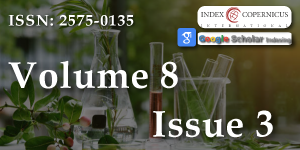Dynamics of Siberian Fir Stands in Forest Ecosystems of Eastern Sayan Spurs
Main Article Content
Abstract
Dynamics of Siberian fir stands in forest ecosystems of the Eastern Sayan spurs were studied before and during the period of polygraph infestation.
Article Details
Copyright (c) 2024 Bazhina EV, et al.

This work is licensed under a Creative Commons Attribution 4.0 International License.
Neger FW. Das Fir tree dieback in the Saxon and other German low mountain ranges. Tharander yearbook. 1908;58:201–224. Available from: https://www.antikbuch24.de/buchdetails_33756799.html
Wiedermann E. Investigations into fir dieback. Forestry Cbl. 1927;49:759–780. Available from: https://doi.org/10.1007/BF01774334
Ulrich B. An ecosystem hypothesis on the causes of fir dieback (Abies alba Mill.). Forestry CBL Vintage. 1981;100(3–4):228–236. Available from: https://ui.adsabs.harvard.edu/link_gateway/1981FoCen.100..228U/doi:10.1007/BF02640639
Schulze DEB. Forest decline and air pollution: a study of Spruce (Picea, Abies) on acid soils. Berlin: Springer-Verlag; 1989;475. Available from: https://link.springer.com/book/10.1007/978-3-642-61332-6
Hüttl R, Mueller-Dombois D, editors. Forest decline in the Atlantic and Pacific Region. Berlin: Springer-Verlag; 1995. 366. Available from: https://link.springer.com/book/10.1007/978-3-642-76995-5
Cvrčková H, Máchová P, Malá J. Use of nuclear microsatellite loci for evaluating genetic diversity among selected populations of Abies alba Mill. in the Czech Republic. J For Sci. 2015;61(8):345–351. Available from: https://jfs.agriculturejournals.cz/pdfs/jfs/2015/08/04.pdf
Ducci F, De A, Rogatis R, Proietti A, Curtu L, Marchi M, Belletti P. Establishing a baseline to monitor future climate-change-effects on peripheral populations of Abies alba (Mill.) in central Apennines. Ann For Res. 2021;64(2). Available from: https://doi.org/10.15287/afr.2021.2281
Camarero J, Gazol A. Will Silver fir be under higher risk due to drought? A comment on Walder et al. (2021). For Ecol Manage. 2022;503:119826. Available from: http://dx.doi.org/10.1016/j.foreco.2021.119826
Świercz A, Świątek B, Pietrzykowski M. Changes in the concentrations of trace elements and supply of nutrients to silver fir (Abies alba Mill.) needles as a bioindicator of industrial pressure over the past 30 years in Świętokrzyski National Park (Southern Poland). Forests. 2022;13(5):718. Available from: https://doi.org/10.3390/f13050718
Kutnar L, Kermavnar J, Martin A, Pintar A. Climate change and disturbances will shape future temperate forests in the transition zone between Central and SE Europe. Ann For Res. 2022;64(2). Available from: https://www.afrjournal.org/index.php/afr/article/view/2111
Dalmaris E, Tourvas N, Aravanopoulos FA. Genetic diversity of silver fir (Abies alba) and European beech (Fagus sylvatica) populations from the south-eastern limits of their natural distribution. Environ Sci Proc. 2022;22(1):37. Available from: https://doi.org/10.3390/IECF2022-13129
Vjpustková M, Čihák T, Fišer P. The increasing drought sensitivity of silver fir (Abies alba Mill.) is evident in the last two decades. J For Sci. 2023;69:67–79. Available from: https://doi.org/10.17221/172/2022-JFS
Crespo-Antia JP, González de Andrés E, Gazol A, Camarero JJ, Linares JC. Tree-level climate sensitivity reveals size effects and impending growth decline in silver fir affected by dieback. Forests. 2024;15:999. Available from: https://doi.org/10.3390/f15060999
Florian D, Tobias S, Miller W, Honer HN, Larysch E, Puhlmann H, et al. Multivariate drought stress response of Norway spruce, silver fir, and Douglas fir along elevational gradients in southwestern Germany. Front Ecol Evol. 2022;10. Available from: https://doi.org/10.3389/fevo.2022.907492
Oliva J, Colinas C. Decline of silver fir (Abies alba Mill.) stands in the Spanish Pyrenees: role of management, historic dynamics, and pathogens. For Ecol Manage. 2007;252(1–3):84–97. Available from: https://doi.org/10.1016/j.foreco.2007.06.017
Klopcic M, Boncina A. Stand dynamics of silver fir (Abies alba Mill.)-European beech (Fagus sylvatica L.) forests during the past century: a decline of silver fir? Forestry. 2011;84(3):259–271. Available from: https://doi.org/10.1093/forestry/cpr011
Belletti P, Ferrazzini D, Ducci F, De Rogatis A, Mucciarelli M. Genetic diversity of Italian populations of Abies alba. Dendrobiology. 2017;77:147–159. Available from: http://dx.doi.org/10.12657/denbio.077.012
Jean F, Davi H, Oddou-Muratorio S, Fady B, Scotti I, Scotti-Saintagne C, et al. A 14-year series of leaf phenological data collected for European beech (Fagus sylvatica L.) and silver fir (Abies alba Mill.) from their geographic range margins in south-eastern France. Ann For Sci. 2023;80:35. Available from: https://doi.org/10.1186/s13595-023-01193-9
Man'ko YU, Gladkova GA. About factors of damage of fir-spruce forest on Far East. Lesovedenie. 1995;2:3–12.
Man'ko YU, Gladkova GA. About drying off dark-forest in North America. Lesovedenie. 1999;5:56–62. (In Russian).
Manko YI, Gladkova GA. Spruce drying in the light of global deterioration of dark coniferous forests. Vladivostok: Dalnauka; 2001; 228. Available from: https://rusneb.ru/catalog/000199_000009_000723776/
Donaubauer. 1995.
Bazhina EV, Tretyakova IN. To the problem of fir forests desiccation. Uspekhi Sovremnoi Biologii. 2001;121(6):626–631. Available from: https://sciencejournals.ru/list-issues/uspbio/
Debkov NM, Aleinikov AA, Gradel A, Bocharov AYu, Klimova NV, Pudzha GI. Impacts of the invasive four-eyed fir bark beetle (Polygraphus proximus Blandf.) on Siberian fir (Abies sibirica Ledeb.) forests of Southern Siberia. Geogr Environ Sustain. 2019;12(3):79–97. Available from: https://doi.org/10.24057/2071-9388-2019-35
Krivets SA, Kerchev IA, Bisirova EM, Volkova ES, Astapenko SA, Efremenko A, et al. Overview of the current secondary range of the four-eyed fir bark beetle (Polygraphus proximus Blandford) in the Russian Federation. Russ J Biol Invasions. 2024;15(2):180–197. Available from: https://link.springer.com/article/10.1134/S2075111724700061
Pavlov IN, Litovka YU, Golubev DV, Astapenko SA, Khromogin PV, Usol'tseva YU, et al. Mass reproduction of Polygraphus proximus Blandford in fir forests of Siberia infected with root and stem pathogens: monitoring, patterns, biological control. Cont Probl Ecol. 2020;1:89–106.
Alekseev VA. Diagnostics of living state of trees and stands. Lesovedenie. 1989;4:51–57. Available from: https://h.twirpx.one/file/1854998/
Kharuk VI, Im ST, Petrov IA, Dvinskaya ML, Shushpanov AS, Golyukov AS. Climate-driven conifer mortality in Siberia. Glob Ecol Biogeogr. 2020;30(2):543–556. Available from: https://doi.org/10.1111/geb.13243
Tchebakova NM, Parfenova EI, Bazhina EV, Soja AJ, Groisman PY. Droughts are not the likely primary cause for Abies sibirica and Pinus sibirica forest dieback in the South Siberian Mountains. Forests. 2022;13:1378. Available from: https://doi.org/10.3390/f13091378
Tchebakova NM, Bazhina EV, Parfenova EI, Senashova VA. In search of an X factor: a review of publications on the issue of dark-needled forest decline/dieback in Northern Eurasia. Meteorol Hydrol. 2022;(5):123–140.
Fernandez IJ. Air pollution: synthesis of the role of major air pollutants in determining forest health and productivity. In: Stress physiology and forest productivity. Dordrecht; Boston; Lancaster: Martinus Nijhoff Publ. 1986;217–239. Available from: https://link.springer.com/chapter/10.1007/978-94-009-4424-4_11
Bazhina EV. Condition of siberian fir tree stands (Abies sibirica) and distribution of chemical elements by the tiers of its crown in forest ecosystems of spnats south krasnoyarsk region, russia. Nature Conserv Res. 2018;3(Suppl. 2):40–53. Available from: https://ncr-journal.bear-land.org/uploads/15cb75851f8ae3b03674d5ca16a41e58.pdf
Debkov NM, Bisirova EM. The factors of sustainability of Siberian fir to influence by Ussurijsk poligrafus. Lesovedenie. 2020;3:219–230. Available from: https://www.elibrary.ru/item.asp?doi=10.31857/S0024114820020059

